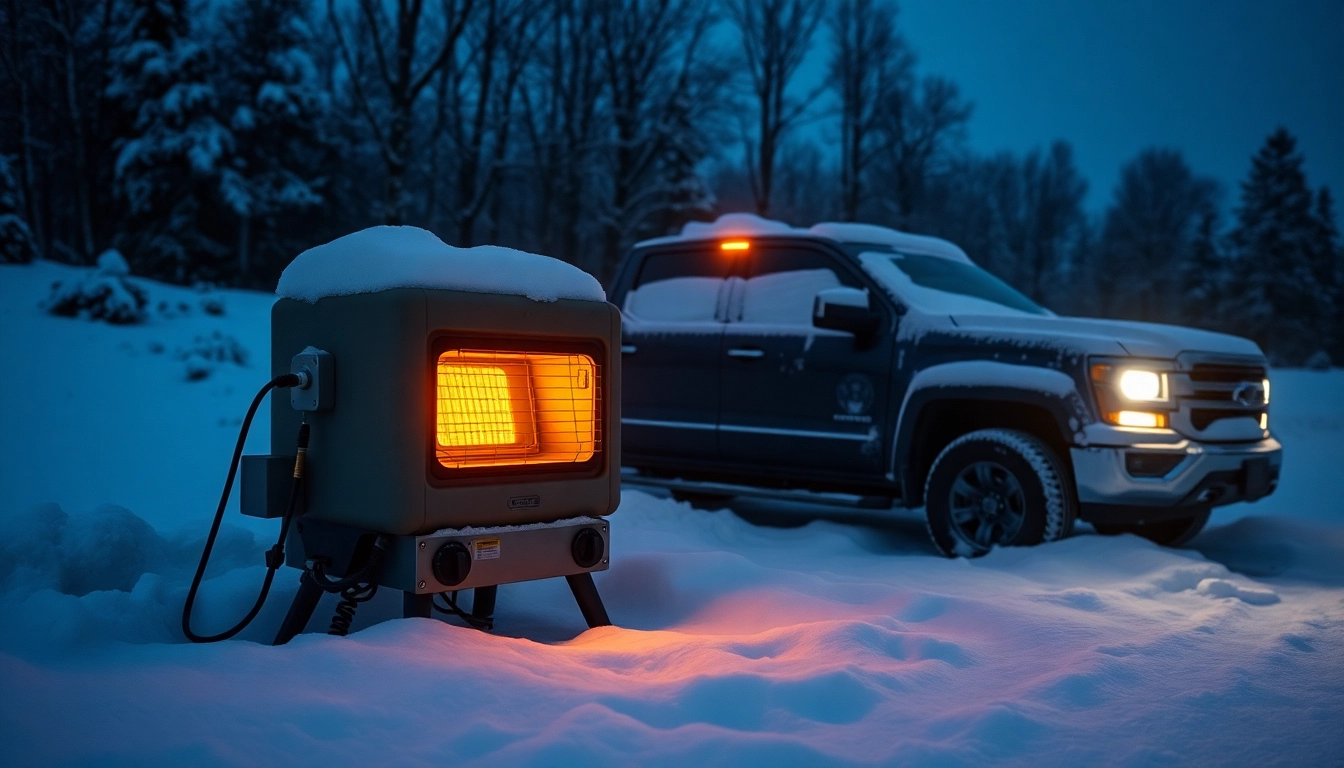Understanding Diesel Block Heaters
What is a Diesel Block Heater?
A diesel block heater is an essential accessory for diesel engines, particularly in regions that experience extremely cold temperatures. It is an electric device designed to warm the engine block, coolant, and oil, ensuring the engine starts quickly and runs efficiently on those frigid mornings. Instead of relying on the engine’s own heat after being turned off, a block heater pre-warms the engine, reducing the wear on components during the starting process and subsequently enhancing overall performance.
How Diesel Block Heaters Work
Diesel block heaters typically operate by using electrical resistance to heat the coolant, which is then circulated through the engine block. They can be integrated into the engine’s cooling system or installed as standalone units. The primary goal is to elevate the engine temperature before startup, which helps to ensure optimal performance and longevity.
The basic operation involves plugging the heater into a standard electrical outlet (usually 120-volt in North America) several hours before starting the engine. Some models feature automatic temperature controls, while others require manual monitoring. Sufficiently heating the engine block makes starting easier and decreases the likelihood of damage from cold starts, where oil can thicken and inhibit proper lubrication.
Benefits of Using a Diesel Block Heater
- Improved Start-Up Performance: Block heaters ensure that your diesel engine starts quickly, reducing the risk of battery failure due to excessive cranking.
- Enhanced Fuel Efficiency: A warmed engine achieves optimal combustion more efficiently, leading to lower fuel consumption.
- Reduced Wear and Tear: Starting a cold engine can create undue stress on engine components. Using a block heater minimizes this stress and prolongs engine life.
- Better Emissions Control: A properly warmed engine burns fuel more cleanly, contributing to lower emissions during operation.
When to Use a Diesel Block Heater
Recommended Temperatures for Activation
Most diesel manufacturers recommend using a block heater when temperatures dip to 20 degrees Fahrenheit (-6 degrees Celsius) or lower. At these temperatures, diesel fuel can thicken, making it challenging for the engine to start effectively without assistance. The performance of diesel engines can also be compromised in extremely cold weather, leading to inefficient combustion and increased exhaust emissions.
In cases where temperatures are extremely low, using the block heater becomes even more critical. Engine designs continue to improve, but even modern engines benefit significantly from pre-heating to ensure smooth starts.
Long-term Effects of Not Using a Block Heater
Failing to utilize a block heater in cold conditions can lead to several long-term issues. The most immediate consequence is increased wear on engine parts and battery strain due to excessive cranking in cold starts. Additionally, operating a cold engine can result in poor fuel combustion and increased deposits in the combustion chamber, which can severely impact engine efficiency over time.
Moreover, the frequent need for jump-starts or battery replacements can become costly, and in some cases, ignoring the benefits of a block heater could lead to premature engine failure. For diesel engines, where tolerance to cold conditions is lower than their gasoline counterparts, the need for starting assistance cannot be overstated.
Signs Your Diesel Needs a Block Heater
Several indicators can help you determine if your diesel engine would benefit from a block heater:
- The engine struggles to crank or starts sluggishly in cold weather.
- You notice that the engine takes longer to warm up to its optimal operating temperature.
- Excessive exhaust smoke upon startup is noticeable.
- Engine oil appears excessively thick when checking the dipstick.
If you observe any of these issues, it might be time to invest in a diesel block heater for your vehicle to ensure a reliable and efficient starting experience in cold weather.
Types of Diesel Block Heaters
Circulating vs. Immersion Block Heaters
There are two primary types of diesel block heaters: circulating heaters and immersion heaters. Each type has its specific application and advantages.
Circulating Heaters
Circulating heaters are installed within the engine’s cooling system. They work by heating the coolant in the engine and then circulating it through the engine block and heater core. This method provides uniform heating, leading to faster startup times. These heaters are typically more complex to install but offer superior efficiency and heating performance.
Immersion Heaters
Immersion heaters, on the other hand, are directly installed into the engine block and provide heat directly to the engine oil or coolant. These heaters are easier to install, making them favorable for DIY enthusiasts. However, they may not distribute heat as evenly as circulating heaters, leaving some areas of the engine cooler than others.
Choosing the Right Wattage for Your Engine
When selecting a block heater, wattage plays a crucial role in its effectiveness. The wattage commonly ranges from 300 to 1500 watts. Higher wattage heaters warm up the engine faster but can be more demanding on your electrical system.
As a general guideline, most diesel engines require a 750-1000 watt heater for effective heating; however, larger engines or those in extremely cold climates may benefit from a higher wattage unit. It’s essential to consult the vehicle’s owner manual or a professional for recommendations tailored to your specific engine type.
Pros and Cons of Each Type
Here’s a breakdown of the pros and cons of both circulating and immersion heaters:
Circulating Heaters
- Pros:
- Even heat distribution throughout the engine.
- Quick heat-up times, ideal for extremely cold weather.
- Long-term reliability.
- Cons:
- More complicated installation.
- Higher cost compared to immersion heaters.
Immersion Heaters
- Pros:
- Simple installation process.
- Less expensive than circulating heaters.
- Cons:
- Potential for uneven heating.
- May require additional maintenance.
Installing a Diesel Block Heater
Step-by-Step Installation Guide
Installing a diesel block heater can be done as a DIY project or undertaken by a professional. Here’s a step-by-step guide for those opting for DIY:
- Gather Necessary Tools: Ensure you have the right tools such as wrenches, sockets, and screwdrivers, along with the block heater kit.
- Prepare Your Vehicle: Disconnect the battery to ensure safety during installation.
- Locate the Installation Point: Identify the best location for the heater, usually on an accessible part of the engine block.
- Drain Coolant: To prevent spills, drain some coolant from the engine block.
- Install the Heater: Following the manufacturer’s instructions, install the block heater into the designated spot in the engine.
- Reconnect Coolant and Battery: Refill your coolant and reconnect the battery.
- Test the Heater: Plug it in and allow it to operate for a few hours. Attempt to start the engine to check for functionality.
Common Mistakes to Avoid
While installation can appear manageable, several common mistakes can hinder optimal function:
- Failing to disconnect the battery, which can lead to shocks or shorts.
- Using excessive force during installation, potentially damaging the heater or engine.
- Not refilling coolant after installation, which can lead to engine damage.
- Choosing the wrong heater size or wattage for your specific engine type.
Professional Installation vs. DIY
Hiring a professional can offer peace of mind in terms of correctness and safety but may come at an additional cost. If you’re confident in your mechanical skills and can dedicate time to the installation, DIY is an option. Just ensure to follow guidelines rigorously and consider seeking assistance if you’re ever uncertain during the installation process.
Maintaining Your Diesel Block Heater
Regular Maintenance Tips
To ensure your diesel block heater stays functional throughout its lifespan and operates efficiently, adhere to regular maintenance tips:
- Inspect the heater for any visible damage or wear annually.
- Ensure connections remain secure and free from corrosion.
- Test the heater’s function by plugging it in before the cold season begins.
- Follow the manufacturer’s recommended operating guidelines in terms of utilization time.
Signs of Wear and Tear
As with any mechanical part, block heaters can experience wear over time. Notable signs include:
- Increased starting difficulties even after using the block heater.
- Unusual noises coming from the heater during operation.
- Visible cracks or damage on the unit itself.
- Leaking coolant around the installation point.
How to Troubleshoot Block Heater Issues
If your block heater isn’t functioning properly, troubleshooting can help identify the issue:
- Check for power issues: Ensure that the outlet is working by plugging in another device.
- Inspect the wiring: Look for loose connections or damaged wires.
- Examine the heater unit: Look for cracks or physical damage that may impair function.
- Review installation: Ensure the heater is appropriately installed according to the manufacturer’s guidelines.






